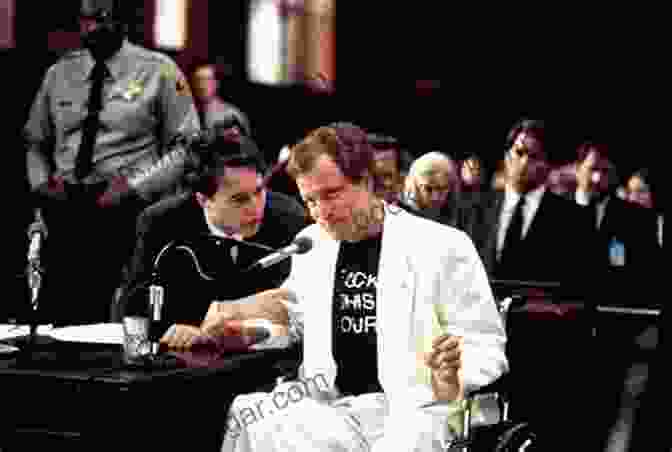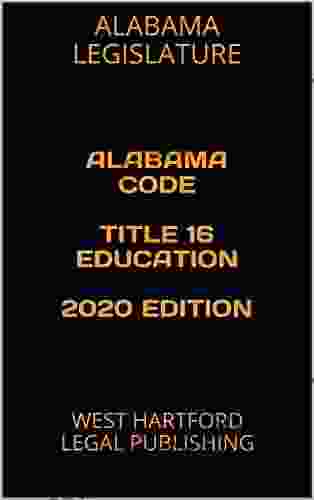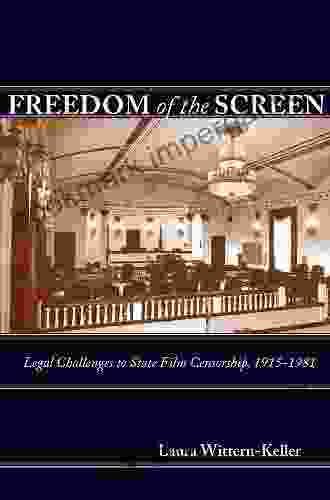Unveiling the Legal Battles: A Historical Perspective on State Film Censorship in the United States (1915-1981)

5 out of 5
| Language | : | English |
| File size | : | 1696 KB |
| Text-to-Speech | : | Enabled |
| Screen Reader | : | Supported |
| Enhanced typesetting | : | Enabled |
| Word Wise | : | Enabled |
| Print length | : | 368 pages |

The world of cinema has always been a captivating blend of art and commerce, a reflection of our societal norms and a catalyst for cultural change. However, the path of filmmaking has often been fraught with challenges, particularly in the realm of censorship. In the early days of the 20th century, as the motion picture industry burgeoned, so too did concerns over its potential impact on public morality. This led to the rise of state film censorship boards, tasked with the formidable responsibility of determining what films could be exhibited to the public.
The legal challenges to state film censorship in the United States represent a significant chapter in the history of freedom of speech and artistic expression. For over six decades, filmmakers, distributors, and civil liberties organizations waged a relentless battle against the constraints imposed by these censorship boards. The legal battles that ensued were not only about the fate of individual films but also about the fundamental principles of constitutional law and the delicate balance between the government's interest in protecting society and the individual's right to free expression.
The Seeds of Censorship: The Rise of State Film Boards
The roots of film censorship in the United States can be traced back to the early 1900s, a time of rapid social and technological change. As the popularity of motion pictures surged, concerns grew about their potential influence on the public, particularly on the minds of young people. In response, local authorities began to enact ordinances giving them the power to censor films. By 1915, over 30 states had established film censorship boards, each with its own set of standards for determining which films were deemed acceptable for public viewing.
The standards employed by these censorship boards were often vague and subjective, leaving filmmakers and distributors uncertain about what content might be deemed objectionable. Films were banned for a wide range of reasons, including profanity, nudity, violence, and depictions of controversial social or political issues. The lack of clear guidelines and the arbitrary nature of the censorship process led to widespread frustration and resentment within the film industry.
The Legal Challenges Begin: Mutual Film Corporation v. Industrial Commission of Ohio
In 1915, the film industry launched its first major legal challenge to state film censorship. In Mutual Film Corporation v. Industrial Commission of Ohio, the Supreme Court ruled that films were protected by the First Amendment and could not be censored simply because they contained controversial or unpopular ideas. However, the Court also upheld the right of states to regulate films that were "obscene, indecent, or immoral." This decision set the stage for a decades-long legal battle over the definition of obscenity and the scope of government censorship.
Over the following decades, the Supreme Court issued a series of rulings that gradually expanded the scope of First Amendment protection for films. In 1952, in Joseph Burstyn, Inc. v. Wilson, the Court struck down a New York law that banned the film "The Miracle" on the grounds of sacrilege. The Court held that the film's religious content could not be used to justify its censorship.
In 1964, in Jacobellis v. Ohio, the Court further clarified the test for obscenity, ruling that a film could only be banned if it was "utterly without redeeming social value." This decision made it more difficult for states to censor films on the grounds of obscenity.
The Demise of State Film Censorship: Erznoznik v. City of Jacksonville
The final blow to state film censorship came in 1981, in Erznoznik v. City of Jacksonville. In this case, the Supreme Court ruled that a Jacksonville ordinance requiring all films to be submitted to the city's censorship board for approval was unconstitutional. The Court held that the ordinance was an unconstitutional prior restraint on speech and that the city's interest in protecting its citizens from exposure to harmful content could not justify such a broad censorship scheme.
The Erznoznik decision effectively ended state film censorship in the United States. Since then, the Supreme Court has continued to uphold the First Amendment rights of filmmakers, striking down laws that seek to restrict the distribution or exhibition of films based on their content.
: The Legacy of State Film Censorship
The legal challenges to state film censorship in the United States were a pivotal chapter in the history of freedom of speech and artistic expression. The battles waged by filmmakers, distributors, and civil liberties organizations helped to establish the principle that films are protected by the First Amendment and cannot be censored simply because they contain controversial or unpopular ideas.
The legacy of state film censorship is a complex one. While censorship boards may have once been seen as a necessary tool for protecting public morality, they ultimately proved to be an ineffective and arbitrary means of regulating film content. The legal battles that led to the demise of state film censorship not only expanded the scope of First Amendment protection for films but also set an important precedent for the protection of free speech in all its forms.
5 out of 5
| Language | : | English |
| File size | : | 1696 KB |
| Text-to-Speech | : | Enabled |
| Screen Reader | : | Supported |
| Enhanced typesetting | : | Enabled |
| Word Wise | : | Enabled |
| Print length | : | 368 pages |
Do you want to contribute by writing guest posts on this blog?
Please contact us and send us a resume of previous articles that you have written.
 Book
Book Novel
Novel Page
Page Chapter
Chapter Text
Text Story
Story Genre
Genre Reader
Reader Library
Library Paperback
Paperback E-book
E-book Magazine
Magazine Newspaper
Newspaper Paragraph
Paragraph Sentence
Sentence Bookmark
Bookmark Shelf
Shelf Glossary
Glossary Bibliography
Bibliography Foreword
Foreword Preface
Preface Synopsis
Synopsis Annotation
Annotation Footnote
Footnote Manuscript
Manuscript Scroll
Scroll Codex
Codex Tome
Tome Bestseller
Bestseller Classics
Classics Library card
Library card Narrative
Narrative Biography
Biography Autobiography
Autobiography Memoir
Memoir Reference
Reference Encyclopedia
Encyclopedia Iris Murdoch
Iris Murdoch Mark Bulik
Mark Bulik Ian K Smith
Ian K Smith Ira Berlin
Ira Berlin Rina Arya
Rina Arya Ian Blair
Ian Blair Ilana Pardes
Ilana Pardes Jack Guinness
Jack Guinness I W Fong
I W Fong J Edward Conway
J Edward Conway Kenneth Kelly
Kenneth Kelly Iggy Pop
Iggy Pop Ilyse Hogue
Ilyse Hogue M Keith Booker
M Keith Booker Howard Zinn
Howard Zinn Satinder Ahuja
Satinder Ahuja Jack Billups
Jack Billups Quick Start Guides
Quick Start Guides Steven H Miles
Steven H Miles Ina May Gaskin
Ina May Gaskin
Light bulbAdvertise smarter! Our strategic ad space ensures maximum exposure. Reserve your spot today!

 Charlie ScottMastering Asphalt Pavement Construction: A Comprehensive Guide to Compaction...
Charlie ScottMastering Asphalt Pavement Construction: A Comprehensive Guide to Compaction...
 Morris CarterYour Career, Your Choice: Unlock Your True Potential and Craft a Fulfilling...
Morris CarterYour Career, Your Choice: Unlock Your True Potential and Craft a Fulfilling...
 Charles ReedAn Unnatural History of Emerging Infections: Uncovering the Hidden Threat to...
Charles ReedAn Unnatural History of Emerging Infections: Uncovering the Hidden Threat to... Lord ByronFollow ·11.3k
Lord ByronFollow ·11.3k Jeff FosterFollow ·7.5k
Jeff FosterFollow ·7.5k Donovan CarterFollow ·6k
Donovan CarterFollow ·6k Robert FrostFollow ·9.4k
Robert FrostFollow ·9.4k Ben HayesFollow ·9.5k
Ben HayesFollow ·9.5k Denzel HayesFollow ·15.4k
Denzel HayesFollow ·15.4k Ernest J. GainesFollow ·14.9k
Ernest J. GainesFollow ·14.9k Floyd PowellFollow ·14.7k
Floyd PowellFollow ·14.7k

 Mike Hayes
Mike HayesUnlock Your Nonprofit Potential: A Comprehensive Guide to...
: Embarking on the Path to Impactful...

 Cody Russell
Cody RussellUnlock the Secrets of Captivating Radio Programming:...
In the fiercely competitive world of...

 Aron Cox
Aron CoxUnveiling the Enchanting World of Beth Inspired Eye...
A Realm of Imagination and Wonder Embark on...

 Felix Carter
Felix CarterUnlock the Secrets of Legal Publishing with West Hartford...
West Hartford Legal Publishing, the renowned...

 Henry Hayes
Henry HayesUnveiling the Secrets of the Panama Papers: Exposing...
The Panama Papers is a groundbreaking...
5 out of 5
| Language | : | English |
| File size | : | 1696 KB |
| Text-to-Speech | : | Enabled |
| Screen Reader | : | Supported |
| Enhanced typesetting | : | Enabled |
| Word Wise | : | Enabled |
| Print length | : | 368 pages |








